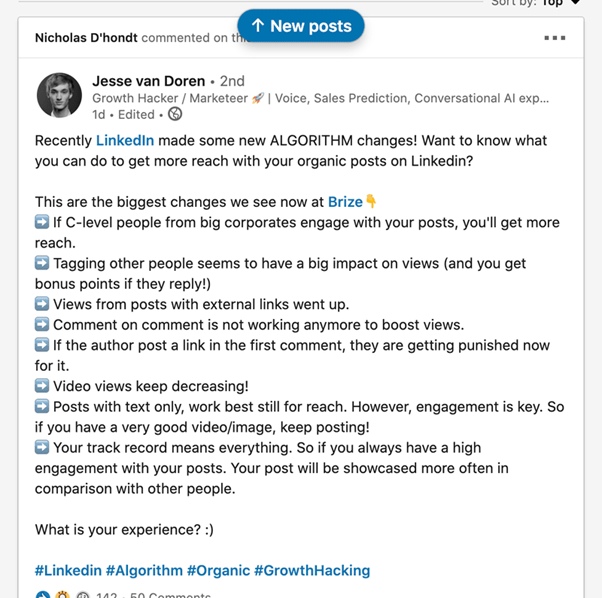LinkedIn is the prime place for hearing inspiring anecdotes about people getting hit by buses and immediately going to their job interviews, only for the interviewer to be...the bus itself. Woah. It just shows that with hard work and dedication, you too can be run over by a bus. 💸😤👌

So, you've got a similar anecdote. Maybe it's involving a tuk-tuk, or a people carrier. But you need the world to see it, of course. With 89% of B2B marketers utilising the social media networking platform, LinkedIn is the place for you.
The TLDR; is: consistency, regularity, and consistency. And consistency.
You can have a limited number of posts, a low level of engagement, but if you post regularly, with no holidays, the LinkedIn algorithm will favour this 'natural' posting schedule. Posts can sometimes even be penalised for appearing at the exact same time every day.
This might mean posting high-quality content frequently, at irregular intervals, including the weekend.
Most of all, content is ranked and displayed based on your account's reputation, how users have engaged before, and what else is being posted.
LinkedIn's algorithm, like many others (apart from Instagram), is a well-kept secret. But, thanks to research, observation, and trial and error, a few key tip and tricks have emerged. We're having to rely on the experiences of companies, who deal day to day with the platform, with entrepreneurs such as Jesse van Doren sharing his company's view of the algorithm changes:
So, let's dive into the process, and ask:
How does the LinkedIn algorithm work?
Filter number one. The basics. The algorithm sifts through the feed, and determines what's good stuff, what's bad stuff, and what's straight up spam.
Filter number two. The engagement. Now, your post appears in the feed temporarily. The bots will keep a cyber-eye on how your audience is interacting with the content. If they like, comment, and share, you'll move onto the next round. If they hide it from their feed, or report it as spam, no.1 ouch, no.2 you'll be filtered out.
Filter number three. The frequency. At this step, the algorithm looks beyond the content, looking at your profile and network to decide whether your post is spam. If things go wrong at this stage, LinkedIn can remove your content from the feed, or at least will display it less frequently.
Filter number four. The Learning. Editors will now review your post to determine if it should keep showing, or if they could include it somewhere else on the network, They will also use the case to derive any takeaways, so the algorithm can be smarter in the future.
So, if your content keeps getting engagement, it can stay on people's feed for weeks, something unheard of on Twitter or Facebook.
So, what type of content does the algorithm prioritise?
- Content from users who you've engaged with in the past
- Users who post consistently
- Users who get large amounts of engagement
- Lengthy comments, over a high volume of reactions
- Native content, such as text posts, images with text, videos with text
- Users you're connected with
- Comments, over reactions, over shares
- Posts with hashtags with more than three hashtags, but less than 10.
- Short, succinct video clips, over long ones.
And does not prioritise:
- Content from business pages
- Videos. Videos are no longer prioritised over text-only or photo-based posts. This is a newer change - videos used to go straight to the top, but this is no longer true.
Updates for 2021.
Let's talk more about video.
While video is still important to the 2021 algorithm, it's not as video-focused as it was in the past. Now, videos have to get good engagement to be prioritised, but they might still have an advantage over static content.
Something else the platform is shaking up in regards to their algorithm, is their approach to mega influencers. LinkedIn de-prioritises content from these mega-influencers, to give users the chance to see less famous posters and creators.
Another update is the factoring in of "dwell time" into the algorithm. This is how long your audience will spend digesting your content. If the number is higher, more people will have your post beamed into their eyeballs.
Top tips for beating the algorithm.
In the right corner, it's you. In the left corner, it's the unfathomable, constantly shifting, all powerful, constantly learning, LinkedIn algorithm. You'll be fine. Ding Ding Ding.
- Think Headline. Your headline on LinkedIn is highly searchable, and can be up to 120 characters. Remember, it's not all about the posts, but about you as a person. Your headline is not just your job title, it's who you are, and what you do.
- Go Big With Your Profile Summary. Make sure you include keywords relevant to your industry and specific role. Lee Woodrow suggests taking these 6 steps:
Value proposition statement (VPS)
Followed by 4-5 core strengths with business benefits
Short synopsis of your career, name dropping blue-chip companies
2 career highlights written in SAR (situation, action and result with metrics)
List of keywords that you want to rank for
3 relevant hashtags - Utilise business owners' and employees' profiles. Don't just focus on the business page.
- Don't be too afraid to post external links. But keep it to around 20% of the time.
- Spark a conversation. Single word answers aren't useful, so make sure the algorithm is getting to see long, higher quality comments. That means creating posts that are conversation starters.
- Consider the times you're posting. Keep any eye on these four categories:
Best time to post: 8-10am & 5pm Tuesday-Thursday
Most clicks or shares: Tuesdays 11am-12pm
Peak time of use: 12pm & 5-6pm weekdays
The worst time to post: 10pm-6am

- Try out A/B testing. A/B testing with tools and analytics on LinkedIn is essential to monitor the content performance. Keep revising and experienmenting to see what's the best for your industry and audience.
- Text + Document = Success. Andy Foote explains which type of content performs well on LinkedIn. According to Andy’s research & study:
“I’ve settled into a routine of mostly posting text plus a picture or text plus a document. I get decent views/engagement. And was buoyed to see that LinkedIn recently added a Documents tab in the activity section.”
- Short and Sweet. If you're a video marketer, keep in mind the kind of video content the platform likes. Make your clips up to a minute long, and add subtitles.
- Make it mobile. Lot's of users access the network from their phones, so make sure your posts align with mobile viewing, with interesting messages and engaging images. Remember the more interaction, the more friendly the algorithm.
- Grow your network. LinkedIn decides the relevance of your posts by looking at your audience’s profiles. That is the demographic information it can work with, so it’s a large part of what the algorithm is based on.
- Money in, money out. LinkedIn rewards pages that invest back into the platform. Having an extensive paid strategy will also benefit your organic feed.

